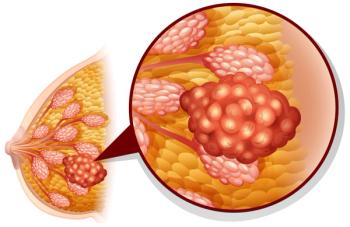
Sotorasib Combo Has Positive PFS Impact in KRAS G12C-Mutated CRC

Combining sotorasib with panitumumab may reduce the burden of disease in patients with KRAS G12C-mutated metastatic colorectal cancer.
Treatment with sotorasib (Lumakras) plus panitumumab (Vectibix) has conclusively demonstrated a positive progression-free survival (PFS) impact among patients with metastatic colorectal cancer (CRC) harboring KRAS G12C mutations, according to Marwan G. Fakih, MD.
Fakih spoke with CancerNetwork® following the
Topline data from the CodeBreaK 300 trial at the time of the FDA approval showed a median PFS of 5.6 months (95% CI, 4.2-6.3) with sotorasib/panitumumab vs 2.0 months (95% CI, 1.9-3.9) with SOC therapy (HR, 0.48; 95% CI, 0.3-0.78; P = .005). The objective response rate was 26% (95% CI, 15%-40%) vs 0% (95% CI, 0%-7%) in each respective arm.
Fakih is a professor in the Department of Medical Oncology & Therapeutics Research, associate director for Clinical Sciences, medical director of the Briskin Center for Clinical Research, division chief of GI Medical Oncology, and co-director of the Gastrointestinal Cancer Program at City of Hope Comprehensive Cancer Center in Duarte, California.
Transcript:
The sotorasib/panitumumab [combination] reflects a targeted therapy for KRAS G12C, and the CodeBreaK 300 trial shows, conclusively, the positive impact on PFS. The updated data showed a median PFS of [5.6] months, which was superior to trifluridine or regorafenib on the standard-of-care arm, which was 2 months from this study. That was the primary end point of this study, clearly more than doubling the time to progression in patients with metastatic colorectal cancer. There was a strong trend towards improvement in overall survival. The study was a small phase 3 trial, so it was not powered to statistically confirm superiority from the overall survival.
But that’s important; it means that you’re more likely to see responses. [Approximately] 30% of patients will have an objective response with this combination, which is higher than what you would expect with second-line treatment. This combination is approved in more of a third-line setting, but 30% is not a response rate we see with second-line chemotherapy in metastatic KRAS-mutated colorectal cancer, which means that this may palliate the symptoms related to metastatic disease as well. [It won’t] just prolong the time to progression [or] the PFS, but also reduce the burden of disease in patients, which ultimately has a positive impact on their longevity.
Reference
FDA approves sotorasib with panitumumab for KRAS G12C-mutated colorectal cancer. News release. FDA. January 16, 2025. Accessed February 4, 2025. https://shorturl.at/1WviB
Newsletter
Stay up to date on recent advances in the multidisciplinary approach to cancer.



















































































